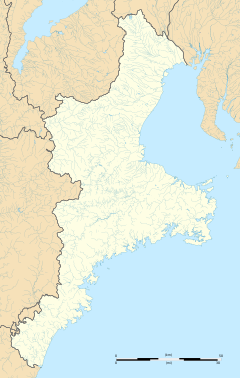Higashi-Aoyama Station
Higashi-Aoyama Station 東青山駅 | |
|---|---|
 Higashi-Aoyama Station | |
| General information | |
| Location | 1074 Uenomura, Tsu-shi, Mie-ken 515-2623 Japan |
| Coordinates | 34°40′33″N 136°19′17″E / 34.6758°N 136.3215°E |
| Operated by | |
| Line(s) | |
| Distance | 91.5 km from Ōsaka Uehommachi |
| Platforms | 2 island platforms |
| Other information | |
| Station code | D56 |
| Website | Official website |
| History | |
| Opened | December 20, 1930 |
| Passengers | |
| FY2019 | 36 daily |
| Location | |

Higashi-Aoyama Station (東青山駅, Higashi-Aoyama-eki) is a passenger railway station in located in the city of Tsu, Mie Prefecture, Japan, operated by the private railway operator Kintetsu Railway.
Lines[edit]
Higashi-Aoyama Station is served by the Osaka Line, and is located 91.5 rail kilometers from the starting point of the line at Ōsaka Uehommachi Station.[1]
Station layout[edit]
The station was consists of two opposed island platforms, connected by an underground passage. The station is unattended.
Platforms[edit]
| 1, 2 | ■ Osaka Line | for Ise-Nakagawa, Ujiyamada, Kashikojima, and Nagoya |
| 3, 4 | ■ Osaka Line | forNabari , Yamato-Yagi and Osaka Uehommachi |
Adjacent stations[edit]
| « | Service | » | ||
|---|---|---|---|---|
| Osaka Line | ||||
| Nishi-Aoyama | Local | Sakakibara-Onsenguchi | ||
| Nishi-Aoyama | Express | Sakakibara-Onsenguchi | ||
| Rapid Express: Does not stop at this station | ||||
History[edit]
Higashi-Aoyama Station opened on December 20, 1930 as a station on the Sangu Kyuko Electric Railway. After merging with Osaka Electric Kido on March 15, 1941, the line became the Kansai Kyuko Railway's Osaka Line.[2] This line was merged with the Nankai Electric Railway on June 1, 1944 to form Kintetsu.[2] On October 25, 1971, due to failure of an ATS system in Aoyama Tunnel, a runaway limited express train derailed in Sodani Tunnel near this station and collided head on with another one, with 25 fatalities (article in Japanese). On November 25, 1975, after a landslide obliterated part of the tracks between this station and Sakakibara-Onsenguchi Station, the tracks were rerouted slightly, a new tunnel was constructed, and a new station building was built. On February 27, 2009 a derailment of a local train occurred at this station, but without fatalities.
Passenger statistics[edit]
In fiscal 2019, the station was used by an average of 36 passengers daily (boarding passengers only).[3]
Surrounding area[edit]
- Aoyama Highlands
- Nunobiki Waterfall
See also[edit]
References[edit]
External links[edit]
![]() Media related to Higashi-Aoyama Station (Mie) at Wikimedia Commons
Media related to Higashi-Aoyama Station (Mie) at Wikimedia Commons
- Kintetsu: Higashi-Aoyama Station(in Japanese)


